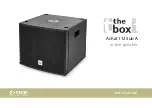
4
CS-810/820/830/840
OUTDOOR COLUMN SPEAKER
Connecting your Speaker System
Connecting your Speaker System
Always switch off the power to the amplifier before connecting speakers.
Choosing the Correct Speaker Cable
It is important to choose cabling designated for audio use and good quality connectors. Using guitar cable or
zip cord (designed for lamps and other electrical use) or poor quality connectors will degrade your
loudspeakers’ audio performance. For distributed loudspeaker systems, we recommend stranded twisted pair
speaker cable with an overall vinyl jacket (plenum rated when installed in required installations).
Always use the appropriate gauge of speaker cable. For cable runs of less than 25 feet (7.5 meters), 18-gauge
cable is adequate. For longer cables, we suggest 16-gauge stranded cable.
Speaker Connection Procedures
After removing approximately 10mm (1/4-inch) of insulation from the ends of the speaker cables, twist the
strands tightly and then twist together with the distribution cable(s), using an appropriate cable connector.
Make certain the wires do not protrude from the cable connector and touch any metal on the speaker chassis, or
any other adjacent metal.
Maintaining Proper Polarity
It is very important to wire your speakers consistently in order to maintain proper polarity. All quality cables are
manufactured with clear markings to identify the different conductors – normally by color-coding, printed
markings, or textured ribbing on the cable’s jacket material. Failing to do so will cause your speakers to operate
out of phase, resulting in significantly reduced low-frequency output from your system.
Choosing the Correct Amplification
When selecting an amplifier for use with your distributed speaker system, it is important to choose an amplifier
that has sufficient power output.
Choosing an amplifier that does not have adequate rated power may result in pushing the amp beyond its limits,
producing distortion or “clipping” of the signal. This can irritate the listener and may cause damage to the speaker.
Choosing an amplifier that is over-powered can result in over-driving the speaker system.
Using Multiple Loudspeakers
It is important to consider the overall speaker load (impedance) when connecting distributed speaker systems to
an amplifier. Some distributed loudspeakers are marked in load impedance; others show the wattage taps.
Whatever the case, it is easy to compute the total impedance (or wattage load) that is possible for a given
amplifier.





























